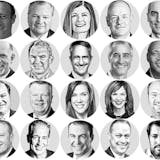When you go back as I did this week and watch a dozen or so times the Vikings' season-ending play in January's 31-24 playoff loss to the Giants — the 4th-and-8 that came up short — you notice a lot.
You are reminded that while the narrative often has been reduced to "Kirk Cousins threw short of the sticks when it mattered most" his options were far from great.
Justin Jefferson? Double-covered. Adam Thielen? Well-covered. K.J. Osborn? He had a half-step over the middle, but his route could have been better. Dalvin Cook? He would have had space in the flat, but a defender was spying on him. T.J. Hockenson? That's where Cousins ultimately went, and he was stopped well short while being well-covered.
All that was unfolding while Cousins was feeling pressure, yet again, up the middle. And the play design, which didn't seem to feature Hockenson as one of the best options, left something to be desired.
One way to mitigate the need for a better immediate option on the play is a mobile quarterback who can escape pressure to either buy time for receivers or run for a first down.
That's both a micro and macro reason I thought the Vikings might draft a mobile quarterback as Cousins' successor in this year's draft — and a reason I still think that will be a sought-out feature of any eventual new young QB.
But as Ben Goessling and I talked about on Tuesday's Daily Delivery podcast, another way to give yourself a better chance on critical third- or fourth-and-long plays is by giving Cousins another target who can: 1) Get open and 2) Do it quickly.
The pick of Addison represented a need, particularly after the Vikings parted ways with the veteran Thielen. At least part of the decision on Thielen was predicated on the fact that he is no longer getting consistent separation from defensive backs.



